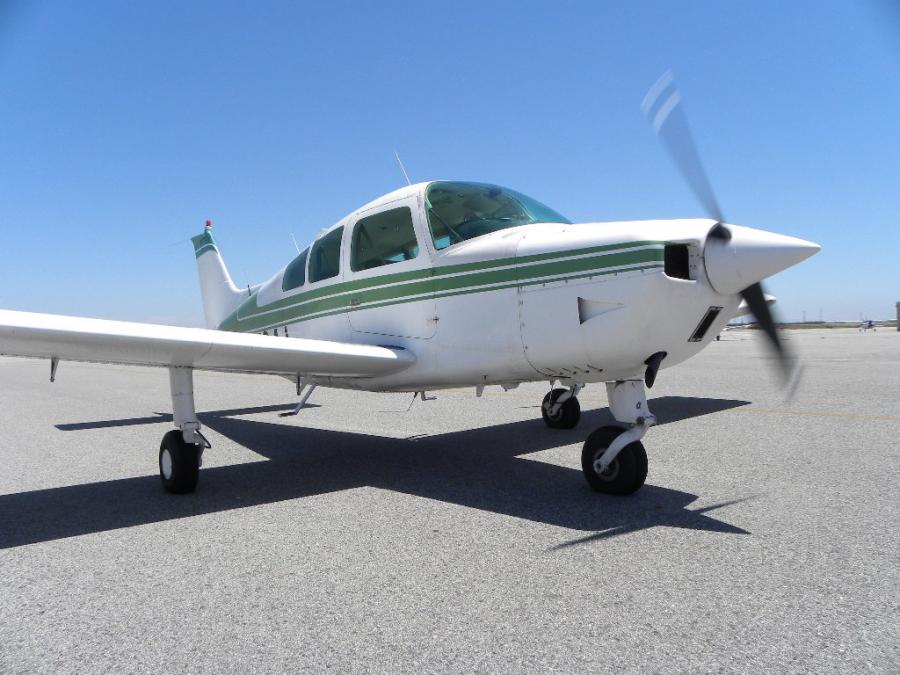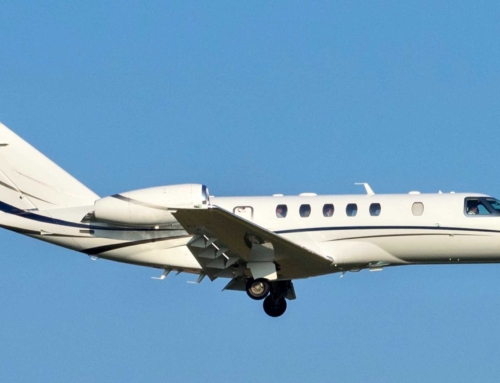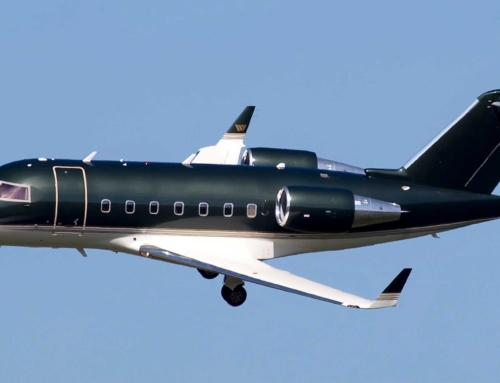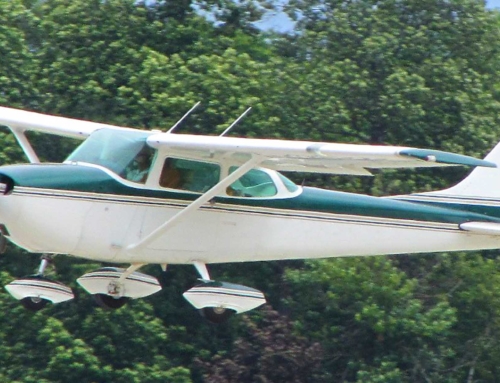Beechcraft Musketeer Sundowner 23 B-C
The Beech Aircraft Corporation was founded in Wichita, Kansas, in 1932. The company started during the Great Depression and just before World War II began. Its founder and President, Walter Beech, led operations until his unexpected death in 1950. Walter’s wife, Olive Ann Beech, worked alongside him as the company’s secretary and treasurer, taking over as President after his death. Olive served in her role for 18 years and was also board chairman until retiring in 1982.
Beechcraft gained its notoriety through its Model 17 Staggerwing during its earlier years producing aircraft. Vice President of Engineering, Ted Wells, led the production of the Staggerwing, which took its first flight in 1932. Beech built 750 more Staggerwings, which impacted its reputation in aviation moving forward.
By 1945, Beechcraft’s famous Bonanza entered the scene. Still the most popular Beechcraft aircraft with the longest production run of any other plane worldwide, it had three essential variants. These variants include the Model 35 Bonanza with its signature V-tail, the conventional-tailed Model 33 Debonair or Bonanza, and the Model 36 Bonanza.
In early 2014, after several financial setbacks over the years, Beechcraft sold to Textron for $1.4 billion. It is now part of the “Big Three” in general aviation manufacturing, including Piper Aircraft and Cessna.
Development Of Beechcraft’s Musketeer
Better known as the B23 series of aircraft, Beechcraft’s Musketeer was the company’s idea of creating a lightweight plane to compete with other popular existing models during the 1960s. World War II caused an increased demand for more lightweight aircraft on the market. But Beechcraft’s challenges included avoiding overproducing an aircraft that no one was interested in or excited about.
In a company meeting, Beechcraft’s Executive Vice President, Frank E. Hedrick, unveiled the Model 23 “Musketeer.” With a starting price of $13,300 featuring standard equipment, the Musketeer was an entry-level plane with a low-wing design and the ability to carry three passengers and one pilot. Aviation enthusiasts also refer to this aircraft as “Baby Beechcraft.”
With a price tag lower than their ever-popular 35, Beechcraft expected more sales and attraction from business travelers, aviation students, and flight schools. In 1963, delivery soared up to 1,000 units. Beechcraft continued to adjust its performance and speed, eventually creating models capable of performing aerobatics.
Overall, Beechcraft’s Musketeer series of aircraft includes the 23 Musketeer and Custom, 19 Musketeer Sport, 23 and 24 Musketeer Super II, 24 Sierra, and CT-134 Musketeer. It was immensely popular with flight training schools during its production before eventually becoming a more privately owned aircraft. This particular series of aircraft is often compared to Cessna’s 172 and Piper’s Cherokee series.
By the 1970s, Beechcraft’s Musketeer Custom III model would be known as the Sundowner. Toward the end of the 1970s, Beechcraft created a twin-engine monoplane called the Model 76 Duchess based on the Musketeer’s design.
- Country of Origin: America
Beechcraft Musketeer Sundowner 23 Statistics
The following are statistics for the latest variation of the Beechcraft Musketeer A23 (1963).
| 127 ks
Maximum Speed |
672 nm
Maximum Range |
4
Maximum Occupants |
1963-1983
Range Of Years Manufactured |
| 1,093
Total Aircraft Build |
454
Total In Service |
1,025 lbs
Useful Load |
$21,253
Average Sale Value |
| Unknown
Average Days On Market For Sale |
Visit VREF Online
VREF Demand Rating |
The following are statistics for the latest variation of the Beechcraft Sundowner C23 (1983).
| 152 kts
Maximum Speed |
600 nm
Maximum Range |
4
Maximum Occupants |
1963-1983
Range Of Years Manufactured |
| 1,093
Total Aircraft Build |
454
Total In Service |
956 lbs
Useful Load |
$60,060
Average Sale Value |
| Unknown
Average Days On Market For Sale |
Visit VREF Online
VREF Demand Rating |
Operational Resources
Local Resources
Manufacturer
Insurance
- BWI Aviation Insurance
- Starr Gate
- Travers Aviation Insurance
- AOPA Insurance
- USAA Aircraft Insurance For Pilots
Beechcraft Musketeer Sundowner 23 B-C Details
The following includes details for the initial 23 Musketeer (1963).
Interior
The initial Musketeer’s cabin accommodates up to 4 occupants, offering standard equipment for the 1960s such as radio communication, factory-installed crystal-controlled navigation/communication, “Ram’s horn” wheel for added comfort, and T-group flight instruments.
Other interior features include armrests, sun visors, cigarette lighters, ashtrays, glove boxes, and more.
Exterior
The Musketeer offers a large windshield for better visibility and two windows on each side of the cabin. It also has a single entry door located on the right side. But buyers could request a left-side door option. The airframe is made of a truss-grid, honeycomb core construction that had been used to build flight control surfaces for the Convair F-106 jet fighter. The 23’s wing also featured a National Advisory Committee for Aeronautics (NACA) laminar-flow airfoil.
Avionics
A 1983 Beechcraft Sundowner may or may not contain the following avionics:
- Dual King Navigation Communication
- CoPilot Alt
- G/S
- DME
- ADF
- Cabin Vent Blower
Specifications
- Height: 8 ft. 3 in.
- Length: 25 ft. 9 in.
- Wing Span: 32 ft. 9 in.
- Cabin Volume: 116 cubic ft.
- Classification: Aerobatic
- Max Take-Off Weight: 2,450 lbs.
- Max Landing Weight: 2,450 lbs.
- Empty Weight: 1,494 lbs.
- Max Payload: 756 lbs.
- Max Range: 600 nm
- Service Ceiling: 12,600 ft.
- Minimum Landing Distance: 1,484 ft.
- Rate Of Climb: 790 fpm
- Max Speed: 152 kts
- Cruise: 118 kts
Beechcraft Musketeer & Sundowner Models
The following is information on all Beechcraft Musketeer and Sundowner models.
23 Musketeer
The first Musketeer received its certification on February 20, 1962. It’s a four-seater lightweight aircraft with fixed tricycle landing gear, powered by a 160-horsepower Lycoming O-320-D2B piston engine. It has a gross weight of 2,300 lbs.
A23 Musketeer II
The A23 Musketeer increased its gross weight from its previous version to 2,350 lbs. This model also seats four and is powered by a 165-horsepower Continental IO-346-A piston engine. It received its certification on June 7, 1963.
A23A
This next variation has the same four-seater, lightweight cabin design with fixed tricycle landing gear and is powered by a 165-horsepower Continental IO-346-A piston engine. This model’s gross weight increased to 2,400 lbs. and received its certification on November 5, 1965.
A23-19 (Model 19)
This model has an optional two or four-seat capacity and is powered by a 150-horsepower Lycoming O-320-E2B, E2C, or E3D piston engine. It has a gross weight of 2,200 lbs. and received its first certification on December 9, 1965.
A23-24
Certified on March 7, 1966, this four or six-seat light cabin aircraft with fixed tricycle landing gear is powered by a 200-horsepower Lycoming IO-360-A2B or A2D. However, when it’s equipped with a constant-speed propeller, it contains a Lycoming IO-360-A1B or an A1D piston engine. It has a gross weight of 2,550 lbs.
A24
This fixed tricycle landing gear, lightweight aircraft seats four to six and is powered by a 200-horsepower Lycoming IO-360-A2B or A2D. When equipped with a constant-speed propeller, it is powered by a Lycoming IO-360-A1B or an A1D piston engine. It has the same gross weight as its predecessor of, 2,550 lbs. This model received its first certification on February 5, 1970.
19A
This two or four-seat aircraft with fixed tricycle landing gear is powered by a 150-horsepower Lycoming O-320-E2B, E2C, or E3D piston engine. It has a lowered gross weight of 2,250 lbs. and received its first certification on August 31, 1967. It is also an approved aircraft in the aerobatic category as of March 12, 1968.
M19A
Powered by a 150-horsepower Lycoming O-320-E2B, E2C, or E3D piston engine, this aircraft seats two with a gross weight of 2,250 lbs. It was first certified on December 9, 1969, which includes the aerobatic category.
B19
First certified on February 13, 1970, including the aerobatic category, this two or four-seat light cabin aircraft with fixed tricycle landing gear is powered by a 150-horsepower Lycoming O-320-E2B, E2C, or E3D piston engine. It has a gross weight of 2,250 lbs.
B23
Powered by a 180-horsepower Lycoming O-360-A2G piston engine, this four-seater aircraft has a gross weight of 2,450 lbs. This variation was first certified on December 13, 1967, later including the aerobatic category on November 22, 1968.
C23
This particular variation is called the Musketeer Custom. First certified on February 13, 1970, including in the aerobatic category, this four-seat light cabin aircraft with fixed tricycle landing gear is powered by a 180-horsepower Lycoming O-360-A4G, A2G, A4J, or A4K piston engine. It has a gross weight of 2,450 lbs. By 1972, with the Musketeer Custom III, it experienced another name change to the Sundowner.
A24R Sierra 200
This variation seats four to six with a retractable tricycle landing gear. It is powered by a 200-horsepower Lycoming IO-360-A1B or A1D piston engine with a gross weight of 2,750 lbs. It received its certification on December 23, 1969.
B24R Sierra 200
The B24 also features a retractable tricycle landing gear, seating four or six, and is powered by a 200-horsepower Lycoming IO-360-A1B6 piston engine. This variation is a new propeller variant with a gross weight of 2,750 lbs. It was first certified on June 18, 1973, but sold as a 1974 model with a new larger rear baggage door.
C24R Sierra 200
First certified October 1, 1976, this four or six-seat light cabin aircraft with retractable tricycle landing gear is powered by a 200-horsepower Lycoming IO-360-A1B6 piston engine. It has a gross weight of 2,750 lbs. and features a newer, larger propeller, which made it 6 knots faster than the “B”.
Top Beechcraft Musketeer & Sundowner Questions
The following are the top questions related to the Beechcraft Musketeer and Sundowner.
How Fast Is A Beechcraft Musketeer?
The exact speed of the Musketeer depends on the model. But according to FlyingMag, the Musketeer’s cruise speeds hover around 110 ktas in 150 horsepower aircraft and 120 to 125 ktas in 180 horsepower examples.
Which Musketeer Is Aerobatic?
Aerobatic capabilities for the Musketeer depend on the model and equipment used. With the right equipment, the A19, B19, and M19 Sports are approved for limited aerobatics.
How Much Does A Beech 18 Cost?
A twin Beechcraft 18 has an estimated retail value range of $69,249 to $124,432 — depending on the model year. Production for this aircraft was from 1945 to 1970.
How Many Beechcraft Sundowners Were Made?
A total of 1,297 Beechcraft Sundowners were produced.
How Much Is A Beechcraft Sundowner?
The estimated retail value of Beech’s Sundowner ranges from $42,042 to $60,060 — depending on the model year. Production for this aircraft was from 1970 to 1983.
How Fast Is A Beechcraft Sundowner?
According to the AOPA, a Beech Sundowner that is lightly loaded at a density altitude of 7,500 feet, balances out at 120 knots at 75% power, 115 knots at 65% power, and 96 knots at 57% power.
Does The Beechcraft Sundowner Have Retractable Landing Gear?
No. The Sundowner has a fixed tricycle landing gear.
Does Beechcraft Still Produce The Musketeer?
No. Production for the Musketeer ended in 1983, moving on to produce the 25 and eventual 26 Wichita.
Related VREF Resources
A Look At The Beechcraft Bonanza V35B TC
Learn More About Beechcraft Bonanza 35 A-P Models
Learn More About Beechcraft Bonanza 33A C-F Models
Top 10 Modifications For Beechcraft Bonanza’s A36
Looking For More Information About Beechcraft’s Musketeer Or Sundowner Models?
Join the AOPA’s trusted partner for aircraft appraisals at VREF Online.







